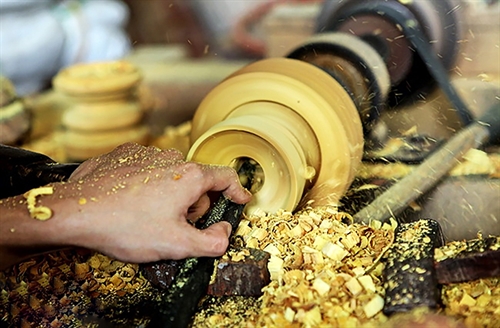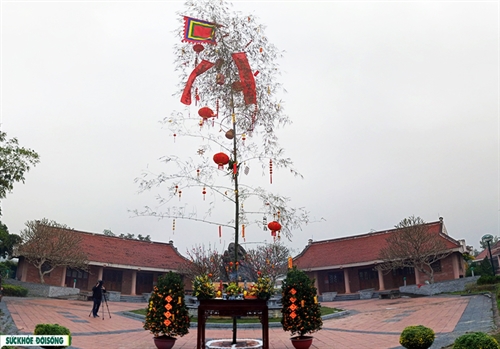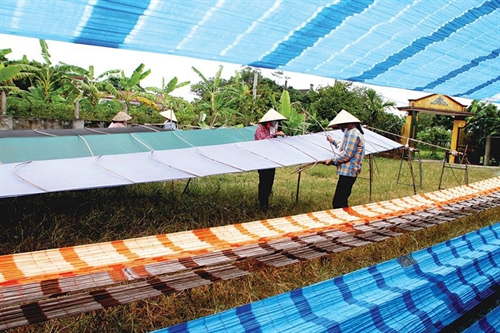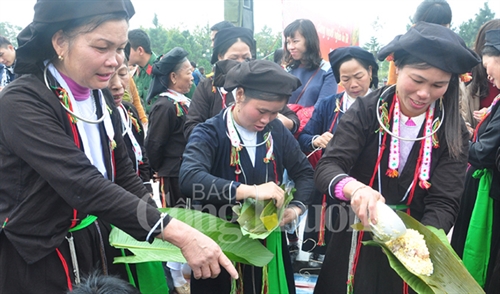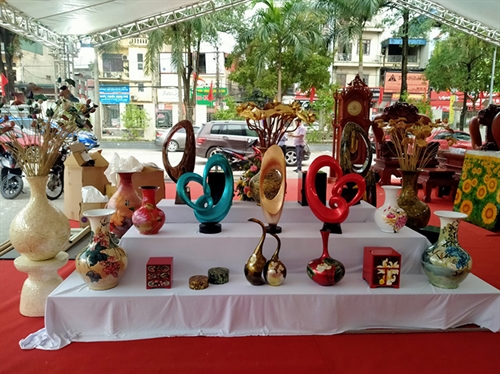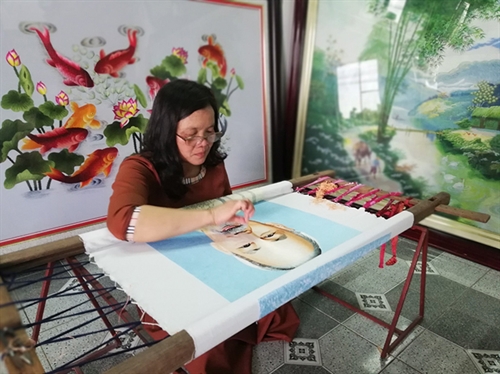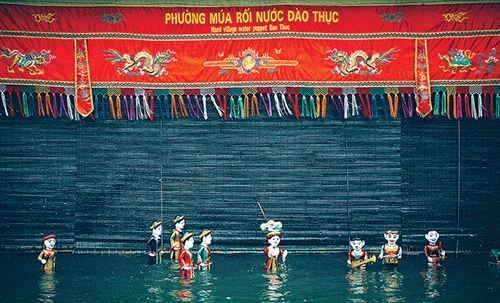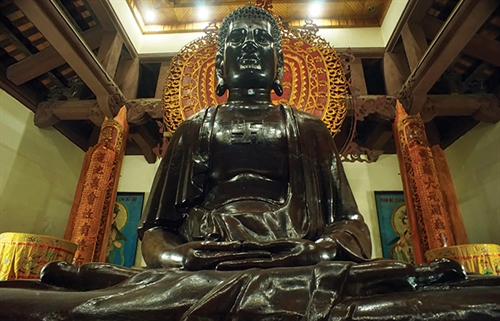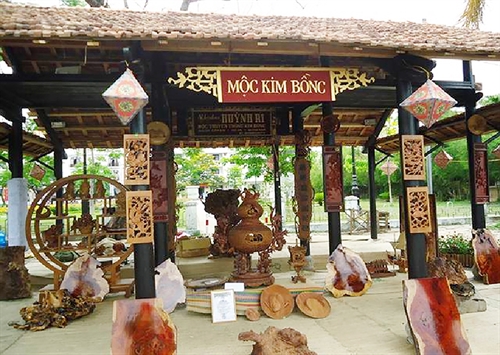Do Thi Nguyet Que
Kieu Ky gold laminating and gilding craft village in Gia Lam district, Hanoi, has a history of about 400 years.
Throughout the years, Kieu Ky villagers have managed to preserve their traditional craft with a craftsmanship process that requires ingenuity and sophistication. Nowadays, all around the country there is no other craft village where the traditional method of beating gold and silver into super-thin gold and silver leaves that can float in water still exists. These gold and silver leaves are often inlaid on lacquered objects, ranging from Buddha statues, hoanh phi cau doi (horizontal boards and pairs of parallel panels engraved with calligraphic characters usually hung at pagodas, temples and worship halls) to decorative items such as vases and souvenirs.
 |
| Gold-laminated products of Kieu Ky village__Photo: Tran Viet/VNA |
The gold laminating and gilding craft is believed to have been founded in the 18th century in the Le Canh Hung reign when a mandarin named Nguyen Quy Tri from northern Hai Duong province passed it down to Kieu Ky villagers. To show gratitude to Tri, Kieu Ky villagers built a temple dedicated to him and since then, they have taken the 17th of the eighth lunar month - the date when Tri said farewell to locals who had been able to master the craft - as his death anniversary. On the 12th of the first lunar month every year, Kieu Ky villagers bring offerings to the temple before returning home to perform rituals to make the first hammer blows in the new year.
The traditional method of gold/silver leaf laminating and gilding constitutes a complicated time-consuming process.
First of all, craftsmen need to prepare “quy” paper - a type of paper made from poonah paper and a special purple-lustered blackish blue ink. However, while poonah paper can be bought from various suppliers, this type of ink is not available in the market.
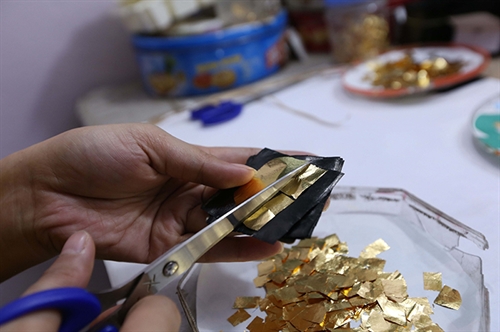 |
| Gold ingots are laminated into thin gold leaves and then cut into small snippets for further processing__Photo: Hoang Hieu/VNA |
To produce the ink, the craftsmen need two ingredients: soot and buffalo leather glue. In order to produce 100 grams of soot, craftsmen need to mix 10 kilograms of resin and longan wood sawdust, roll the mixture into a log and then cut it into toe-sized balls which will be burnt below a cast-iron wok. The craftsmen then collect the soot from the outside bottom of the wok. The making of buffalo leather glue is quite simple but time-consuming as craftsmen have to stew buffalo leather in a water pot for many hours, even a whole day. After the two materials - soot and buffalo leather glue - are ready, craftsmen knead them together and then stew the mixture until it condenses. When the mixture reaches the expected thickness, it will be pounded for around seven hours to smooth black powder which will be mixed with buffalo leather glue again to turn into a thick liquid ink.
The craftsmen then apply this ink on poonah paper sheets, hang them out to dry and then beat them by a hammer to make them thinner and smoother. This process is repeated for three or four times and the final product is called quy paper.
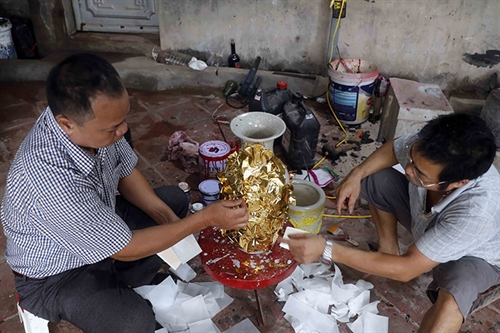 |
| Gilding gold leaves on porcelain vases__Photo: Tran Viet/VNA |
To proceed with the next step, the craftsmen use a hammer to beat a small gold or silver ingot into a long super-thin and malleable ribbon and then cut the ribbon into 1cm x 1cm snippets each will be placed in a quy paper sheet of 6cm x 6cm. The craftsmen then bind quy paper sheets with gold or silver snippets into quires each composed of 490 sheets. Two quires of quy paper sheets will be bound together and wrapped in a raw cloth and dried overnight above a stove. The next morning, the craftsmen will place a packet of quy paper sheets on a stone anvil and beat it with a special hammer so as to make every gold or silver snippet spreading over the quy paper sheet. After approximately one hour, each gold/silver snippet, which is now of much larger than its original size of 1cm x 1cm, will be cut into 16 smaller snippets each of them will then be stuck to a quy paper sheet of 4.2cm x 4.2cm.
The abovesaid process is repeated one and again until the gold or silver snippets become super-thin gold or silver leaves.
With thousands of hammer blows, a skillful goldbeater may turn a single tael of gold into a sheet of 90cm2 while others may only produce a sheet of 70-75cm2, Emeritus Artisan Le Van Vong told the Vietnam Law & Legal Forum magazine.
Finally, the gold or silver leaves, now extremely light and thin, are separated from quy paper sheets and transferred to another special type of non-sticky papers. They are now ready to be inlaid in stone, steel, glass and wood objects.
In 2021, the craft was recognized as one of eight national cultural heritages by the Ministry of Culture, Sports and Tourism. At present, nearly 50 families in Kieu Ky village still practice the traditional craft, many of whom are large-scale production households.-
